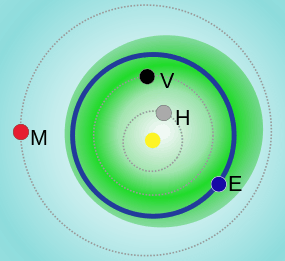4660 Nereus
4660 Nereus /ˈnɪəriːəs/, provisional designation 1982 DB, is a small (about 0.33 kilometres (0.21 mi)) asteroid. It was discovered by Eleanor F. Helin on 28 February 1982, approximately 1 month after a near pass by the Earth.[1]
 Asteroid 4660 Nereus (NASA/JPL 2002) | |
| Discovery[1] | |
|---|---|
| Discovered by | Eleanor F. Helin |
| Discovery site | 1.22-m Samuel Oschin telescope |
| Discovery date | 28 February 1982 |
| Designations | |
| (4660) Nereus | |
| Pronunciation | /ˈnɪəriːəs/[2] |
Named after | Νηρεύς Nēreys |
Apollo  | |
| Orbital characteristics[3] | |
| Epoch 13 January 2016 (JD 2457400.5) | |
| Uncertainty parameter 0 | |
| Observation arc | 12289 days (33.65 yr) |
| Aphelion | 2.024626579 AU (302.8798252 Gm) |
| Perihelion | 0.952824460 AU (142.5405104 Gm) |
| 1.488725519 AU (222.7101677 Gm) | |
| Eccentricity | 0.359973046 |
| 1.82 yr (663.47 d) | |
| 253.788984° | |
| 0° 32m 33.371s / day | |
| Inclination | 1.43182212° |
| 314.458890° | |
| 158.019386° | |
| Earth MOID | 0.00320382 AU (479,285 km) |
| Physical characteristics | |
| Dimensions |
|
Mean radius | 0.165 km |
| 0.33+0.04 −0.01 km2[4] | |
| Volume | 0.019±0.003 km3[4] |
| 15.1 h (0.63 d) | |
Sidereal rotation period | 15.16[4] |
Pole ecliptic latitude | +80°[4] |
Pole ecliptic longitude | +25°[4] |
| 0.54+0.03 −0.09[4] | |
| Xe | |
| 18.2±0.7[3] | |
Nereus is potentially a very important asteroid. It is an Apollo and Mars-crosser, with an orbit that frequently comes very close to Earth, and because of this it is exceptionally accessible to spacecraft. Indeed, because of its small size and close orbit, its delta-V for rendezvous of ~5 km/s is smaller than the Moon's, which is about 6.3 km/s.[5]
Nereus makes seven approaches to Earth of less than 5 million km between 1900 and 2100.[6] The closest will be in February 2060, at 1.2 million km.[6] The next close approach is in December 2021, when it will be 3.9 million km away.[6][7] Its orbital period of 1.82 yr[3] also puts it somewhat near a 2:1 orbital resonance with Earth, which means that an approximately 4-year mission could depart for and return from the asteroid on relatively near passes to the Earth.
Nereus is classified as a potentially hazardous asteroid (PHA),[3] due to both its absolute magnitude (H ≤ 22) and its minimum orbit intersection distance (MOID ≤ 0.05 AU).[8]
The asteroid is classified as E-type, so it could be potentially associated with aubrite meteorites (enstatite achondrites).[4]
Spacecraft
Nereus was proposed for visitation by both the private Near Earth Asteroid Prospector (NEAP) probe, and the Japanese sample return mission Hayabusa. However, the NEAP probe was not realized, and the Hayabusa's launch was delayed by 10 months and the probe had to be redirected to 25143 Itokawa.
4660 Nereus was considered as a flyby target of the NEAR robotic spacecraft mission.[9] NEAR was eventually launched, but visited 253 Mathilde and 433 Eros.
Physical characteristics
Nereus has been imaged by radar, revealing a slightly elongated shape which would allow for stable orbits around it.[4] Earlier optical measurements had given an estimated diameter of about 330±50 meters.[10] More recent work on the analysis of the radar data gives a much more detailed shape for Nereus as well as a fairly detailed terrain map of the surface.
Nereus has a generally ellipsoidal shape with dimensions of 510 m × 330 m × 241 m. On the ends of its longest axis, one end appears narrower and rounder than the other, larger end, making it more of an egg shape. The larger end also appears to have a flatter region on one side of it. Nereus rotates about an axis roughly perpendicular to its longest axis much like a silver spoon spinning on a table.[4]
Name
Although the discoverer is given the opportunity to name the asteroid, Helin donated naming rights to the Planetary Society which organized a naming contest.[11] The winner, Robert M. Cutler, then an employee of NASA contractor The MITRE Corporation, named the asteroid after the ancient Greek proto-god Nereus who had characteristics later attributed to Apollo (prophecy) and Poseidon (a sea god similar to Nereus but with legs rather than a fish tail).
References
- Helin, Eleanor F.; Hulkower, Neal D.; Bender, David F. (January 1984). "The discovery of 1982 DB, the most accessible asteroid known". Icarus. 57 (1): 42–47. Bibcode:1984Icar...57...42H. doi:10.1016/0019-1035(84)90005-8.
- "Nereus". Merriam-Webster Dictionary.
- "4660 Nereus". JPL Small-Body Database. Jet Propulsion Laboratory. SPK-ID: 4660. Retrieved 14 April 2016.
- Brozovic, Marina; et al. (May 2009). "Radar observations and a physical model of Asteroid 4660 Nereus, a prime space mission target" (PDF). Icarus. 201 (1): 153–156. Bibcode:2009Icar..201..153B. doi:10.1016/j.icarus.2008.12.029.
- "NEA delta_v for spacecraft rendezvous missions".
- "NEODys (4660) Nereus". Department of Mathematics, University of Pisa, ITALY. Retrieved 4 May 2009.
- "Solex". Archived from the original on 20 December 2008. Retrieved 3 March 2009.
- "NEO Groups". Near Earth Object Program. NASA. Archived from the original on 2 November 2016.
- Extended-mission opportunities for a Discovery-class asteroid rendezvous mission
- Delbo, Marco; et al. (November 2003). "Keck observations of near-Earth asteroids in the thermal infrared". Icarus. 166 (1): 116–130. Bibcode:2003Icar..166..116D. doi:10.1016/j.icarus.2003.07.002.
- Helin, Eleanor F. (Jan/Feb 1991), "Eureka! The Recovery of 1982DB," pp. 12–16, Planetary Report, Planetary Society, Pasadena, CA.
External links
| Wikimedia Commons has media related to 4660 Nereus. |
- IAUC 3675
- IAUC 3677
- IAUC 3686
- IAUC 5092
- 4660 Nereus at NeoDyS-2, Near Earth Objects—Dynamic Site
- Ephemeris · Obs prediction · Orbital info · MOID · Proper elements · Obs info · Close · Physical info · NEOCC
- 4660 Nereus at the JPL Small-Body Database
